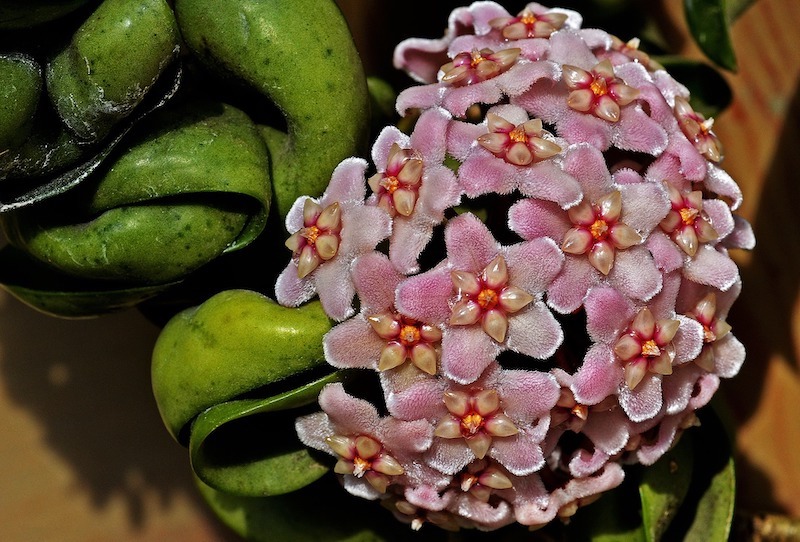Growing Hoya
Hoya is a genus of tropical houseplants, mainly native to Asia. There are hundreds of Hoya varieties, and while each plant has a unique look, most have similar care needs. Hoyas can have trailing vines or a more compact growth habit, depending on the type, and the foliage can be solid green or have hints of cream and pink. Most varieties bloom, and the flowers are generally tiny and sometimes not very showy, but most have a sweet fragrance. Hoyas are members of the succulent family, so taking care of Hoya houseplants is easy, but these plants have specific care requirements. These are slow-growing plants, so proper care helps Hoyas thrive and grow as quickly as possible.

Hoya Sunlight Requirements
Hoyas appreciate medium to bright indirect light. A west- or east-facing window is usually a good location. Too much light can burn the delicate leaves, so keep the plants out of direct light and monitor foliage for signs of scorch. Cultivars with variegated leaves will have a more showy display when grown in higher levels of light. Plants with solid green foliage can grow in medium light. Increase the light levels in the spring to encourage flowering.
Planting Hoya
Hoyas are epiphytic in their natural habitats, which means they grow on trees or rock crevices. As a houseplant, Hoyas require conditions similar to what they experience in nature, so plant them in well-drained soil because any excess moisture can lead to root rot. This plant does well and often blooms when it is slightly rootbound, so don’t be in a rush to repot. Hoyas can live in the same container for years, but when it is time to repot, select a container one inch larger and avoid disturbing the sensitive roots.
Watering Hoya
Hoyas are succulents, so they store water in their thick, waxy leaves. The leaves will wrinkle when the plant is too dry. Water the plant right away if you notice signs of dehydration. The most effective way to determine when a Hoya needs water is to feel the soil. The soil will be dry throughout when the plant needs water. Drench the soil until excess water drains through the container. Hoyas like average humidity and can live in increased humidity but avoid overly dry conditions.

Fertilizing Hoya
Hoya plants are not heavy feeders, but a routine fertilizer application will give the plant a nutritional boost. Feed Hoyas using a balanced fertilizer for succulents once per month. Use a high-phosphorus fertilizer in the spring to promote flowers. A water-soluble fertilizer can be applied during a typical watering session. Always follow the instructions on the packaging to ensure proper dilution. Houseplants may have an extended growing season due to the ideal conditions in a home, but if the plant goes dormant or stops growing in the winter, take a break from fertilizing.
Common Hoya Problems
Get to know your Hoya, and provide the ideal conditions if you would like your plant to bloom. Some Hoya cultivars need slightly colder temperatures in the winter, so relocate the Hoya to an area with temperatures around 60 degrees F during the winter to encourage spring flowers. Hoyas are also more likely to bloom when rootbound, so do not repot your plant too frequently.
Monitor the leaves monthly for discoloration or signs of pests. Yellowing can signify too much or not enough water, while webbing or bumps on the foliage can indicate pests. Catching problems early enables you to take action. Treat the affected areas with neem oil to eliminate pests.

Propagating Hoya
Hoyas can be propagated by cuttings. Cut a section with a couple of leaves and a few growth nodes. Place the nodes in water or soil. Keep the soil consistently damp when propagating plants in soil. Roots should form in a few weeks. Hoyas propagated in water can be planted when the roots are at least one inch long. Gently tug on the plant that is soil propagated, and you’ll know the cutting has set roots if you feel resistance.
Growing Hoya Outdoors
Hoyas do best as houseplants but can be grown outdoors, weather permitting. Move your potted Hoya plant to a deck or patio space when the temperature is consistently above 60 degrees F. Relocate the plant back inside before the weather turns cold. Outdoor sunlight is much more intense than indoor sun, so acclimate your Hoya plant slowly to the change in light and temperature. Place it in a protected location outdoors, out of path of direct sunlight. Water Hoyas when the top layer of soil is dry, and empty any plant saucers.
 |
Author Alison Cotsonas - Published 03-07-2023 |
